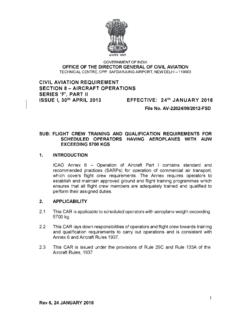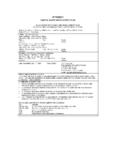Transcription of Management and Recovery of FOG (fats, oils and greases) - …
1 Management and Recovery of FOG. (fats, oils and greases). Published by crew Scotland's Centre of Expertise for Waters. crew connects research and policy, delivering objective and robust research and expert opinion to support the development and implementation of water policy in Scotland. crew is a partnership between the James Hutton Institute and all Scottish Higher Education Institutes supported by MASTS. The Centre is funded by the Scottish Government. This document was produced by: Janice Blanc and Scott Arthur Institute for Infrastructure and the Environment, School of the Built Environment, Heriot-Watt University, Edinburgh, EH14 4AS, Scotland, UK. Please reference this report as follows: Arthur, S. & Blanc, J., (2013), Management and Recovery of FOG (fats, oils and greases), crew project CD2013/6. Available online at: Dissemination status: Unrestricted All rights reserved. No part of this publication may be reproduced, modified or stored in a retrieval system without the prior written permission of crew Management .
2 While every effort is made to ensure that the information given here is accurate, no legal responsibility is accepted for any errors, omissions or misleading statements. All statements, views and opinions expressed in this paper are attributable to the author(s) who contribute to the activities of crew and do not necessarily represent those of the host institutions or funders. Cover photograph courtesy of: Severn Trent Water Contents EXECUTIVE SUMMARY .. 1. INTRODUCTION .. 2. WHY ARE FATS, OILS AND GREASES (FOG) A PROBLEM? .. 2. AIM OF THIS REPORT .. 2. SOURCES OF FATS, OILS AND GREASE .. 2. DOMESTIC SOURCES OF FOG .. 2. COMMERCIAL SOURCES OF FOG .. 3. INDUSTRIAL SOURCES OF FOG .. 3. PROBLEMS IN THE SEWER AND AT WASTE WATER TREATMENT WORKS .. 3. HOW AND WHERE ARE FOG DEPOSITS FORMED? .. 3. Deposit 3. Blockage hot spots'.. 4. WHAT ARE FOG DEPOSITS MADE OF? .. 4. WHY ARE FOG DEPOSITS A PROBLEM? .. 5. WHY ARE OILS THAT DO NOT SOLIDIFY A PROBLEM?
3 5. Management OF FOG .. 6. POLICY AND 6. WASTE LICENSING .. 6. EDUCATION AND AWARENESS .. 6. General campaigns .. 7. Targeted campaigns .. 7. STANDARDS AND GUIDELINES .. 7. EXAMPLE CASE STUDIES .. 8. South East Water Limited, Melbourne, Australia (Scoble and Day, 2002) .. 8. Dublin City Council (O'Dwyer, 2012) .. 9. Severn Trent Water (Mills, 2010) .. 10. CalFOG's Put a lid on it campaign (Harris, 2009) .. 10. Cease the Grease, Dallas Water Utilities .. 10. REMOVAL AND Recovery OF FOG .. 11. REMOVAL AT 11. The use of grease interceptors and traps .. 11. Other options for at source Management .. 12. REMOVAL FROM WITHIN THE SEWER NETWORK .. 12. REMOVAL AT 12. USES FOR RECOVERED FOG .. 13. LAND APPLICATION .. 13. COMPOSTING .. 13. BIODIESEL .. 13. ANAEROBIC DIGESTION AND BIOGAS PRODUCTION .. 15. EXAMPLE CASE STUDIES .. 15. Piedmont biofuels, Central North Carolina (Greer, 2010).. 15. Beckton fat-fuelled' power station, East London (Raleigh, 2013).
4 16. Watsonville, California waste water treatment plant (Kester et al, 2008) .. 16. CONCLUSIONS .. 16. SUMMARY OF 16. RECOMMENDATIONS .. 17. Understanding current conditions .. 17. Education, awareness and engagement .. 17. Licensing, monitoring and enforcement .. 17. REFERENCES .. 18. Executive Summary Background to research There are approximately 200,000 sewer blockages throughout the UK every year. It is estimated around 75% are caused by FOG (Mills, 2010). Problems caused by FOG in the sewer system not only affect the performance of the sewer system and waste water treatment works (WWTW) but may also reduce asset life and increase maintenance costs. This will have an economic impact on the responsible water authorities and will ultimately be reflected in increased prices for customers. In addition, FOG related blockages can result in sewer overflows either as a result of reduced capacity or burst sewer pipes. Objectives of research This report outlines the current state of knowledge regarding best practice for FOG Management at UK and international level.
5 In addition, opportunities for reuse of recovered FOG are explored. Key findings and recommendations Residential and commercial properties both contribute significantly to FOG in the waste water system. Case studies show that an active programme of education, licensing, inspection and enforcement can result in significant reductions in FOG related blockage and sewer overflows. Identification of hot spots of deposition and blockage and the corresponding potential sources of FOG is a fundamental first step towards its Management . An effective FOG Management programme requires a combination of source control and operation and maintenance measures. While fats, oils and greases in the waste water system are a major problem, there is an opportunity to recover these materials and use them beneficially in processes that will improve both the environment and the efficiency of waste water treatment. Key to this is educating and encouraging communities and businesses to think of fats, oil and grease as a valuable commodity rather than waste.
6 Collection at source appears to be the most cost effective option for FOG Recovery . Anaerobic digestion of recovered FOG in combination with other materials and conversion to biodiesel both present opportunities for reducing the cost of operating waste water treatment works while reducing landfill load. Key words Fats, oils and greases; FOG; sewers; best Management practice Page | 1. INTRODUCTION. Why are fats, oils and greases (FOG) a problem? In overview, FOG entering the wastewater system causes a number of problems: They clog the system by restricting capacity, blocking and damaging pipes. This increases both the time and money required for cleaning and maintenance. If not fully removed and treated, the FOG can deplete oxygen in receiving waters. Additional capacity and energy is required at wastewater treatment works to handle excess FOG entering the system. There are approximately 200,000 sewer blockages throughout the UK every year.
7 It is estimated around 75% are caused by FOG (Mills, 2010). An extreme example of FOG related blockage was recently reported by Thames Water (Thames Water, 2013), who discovered a single length of sewer almost completely clogged with over 15 tonnes of fat. This had reduced the sewer to 5% of its original capacity. Problems caused by FOG in the sewer system not only affect the performance of the sewer system and waste water treatment works (WWTW) but may also reduce asset life and increase maintenance costs. This will have an economic impact on the responsible water authorities and will ultimately be reflected in increased prices for customers. In addition, FOG related blockages can result in sewer overflows either as a result of reduced capacity or burst sewer pipes. In response to the discovery of a large fat deposit, Thames Water (2013) reported that If we hadn't discovered it in time, raw sewage could have started spurting out of manholes.
8 Sewer overflows can have significant environmental consequences, including risks to public health because of the exposure to pathogens such as E. coli, which are present in sewage. They can result in reductions of water quality in streams, rivers and lochs and may pollute groundwater. There may also be significant social and economic impacts on individuals and businesses if properties become flooded. If properties have been flooded with sewer water, cleaning up will be unpleasant and costly. In addition, flood from sewers rich in fats can lead to significant land contamination and may result in the need to remove and replace areas of soil. The potential environmental impact of FOG also needs to be taken into consideration during any processing and ultimate disposal. Aim of this report This report outlines the current state of knowledge regarding best practice for FOG Management at UK and international level. In addition, opportunities for reuse of recovered FOG are explored.
9 SOURCES OF FATS, OILS AND GREASE. FOG entering the sewer system comes from a variety of different sources that can be broadly grouped into three categories: domestic, commercial and industrial. Domestic sources of FOG. The biggest problems resulting from FOG within sewers are generally located in areas where commercial premises dominate. Domestic sources are still significant however, particularly at certain times of the year such as Christmas and other occasions where food forms a major part of festival celebrations. In Scotland, Scottish Water (2012) report that 55% of sewer blockages are caused by people disposing of cooking fat down their sink. Significant problems with domestic sources of FOG. were also reported by the Capital Regional District (CRD), an area of British Columbia, Canada. The Page | 2. CRD estimates that almost 1,000,000 kg of fats, oils and grease from residential sources (an estimated 176,993 households and population of 382,250 in 2013 (CRD, 2008)) enter the wastewater system annually: 60% of all FOG entering the system (CRD, 2013).
10 Commercial sources of FOG. Commercial properties appear to be major contributors to FOG in the sewer. For example, the City of Dublin drainage maintenance records indicate that FOG is a serious problem in areas where there are concentrations of Food Service Establishments (FSE) such as pubs, restaurants, hotels, takeaways, convenience stores (Dublin City Council, 2013). Estimates of average annual FOG. production by different types of businesses in Dublin include 624 litres by public houses, 906 litres by fast food outlets and 2353 litres by hospitals; no details are available of the sources of FOG within the different businesses (O'Dwyer, 2012). Industrial sources of FOG. Industrial sources include abattoirs, rendering plants, and food processors and manufacturers. Although the content of any effluent produced is generally controlled through licensing and legislation. Many industrial sources already have processes in place to collect the bulk of material produced.






